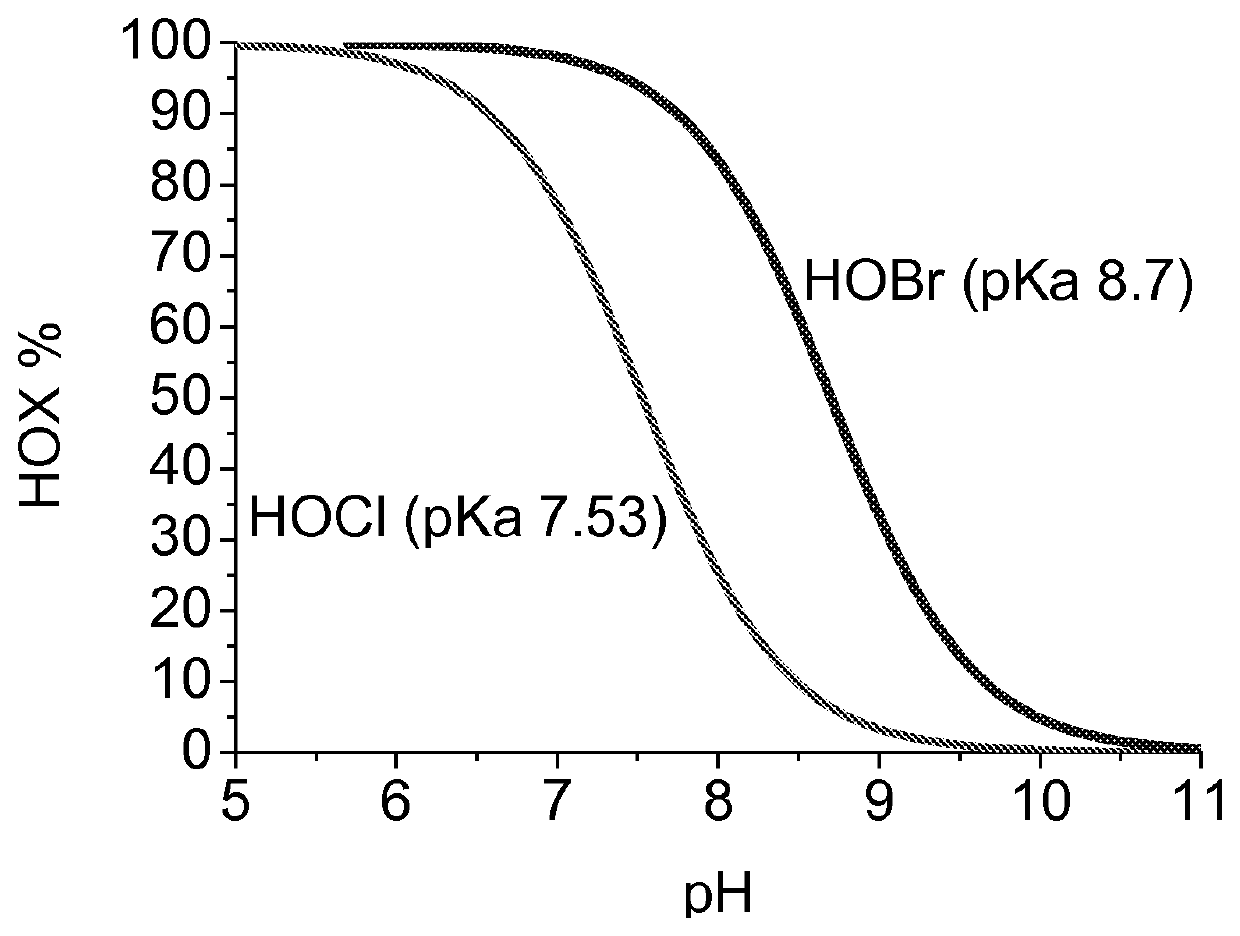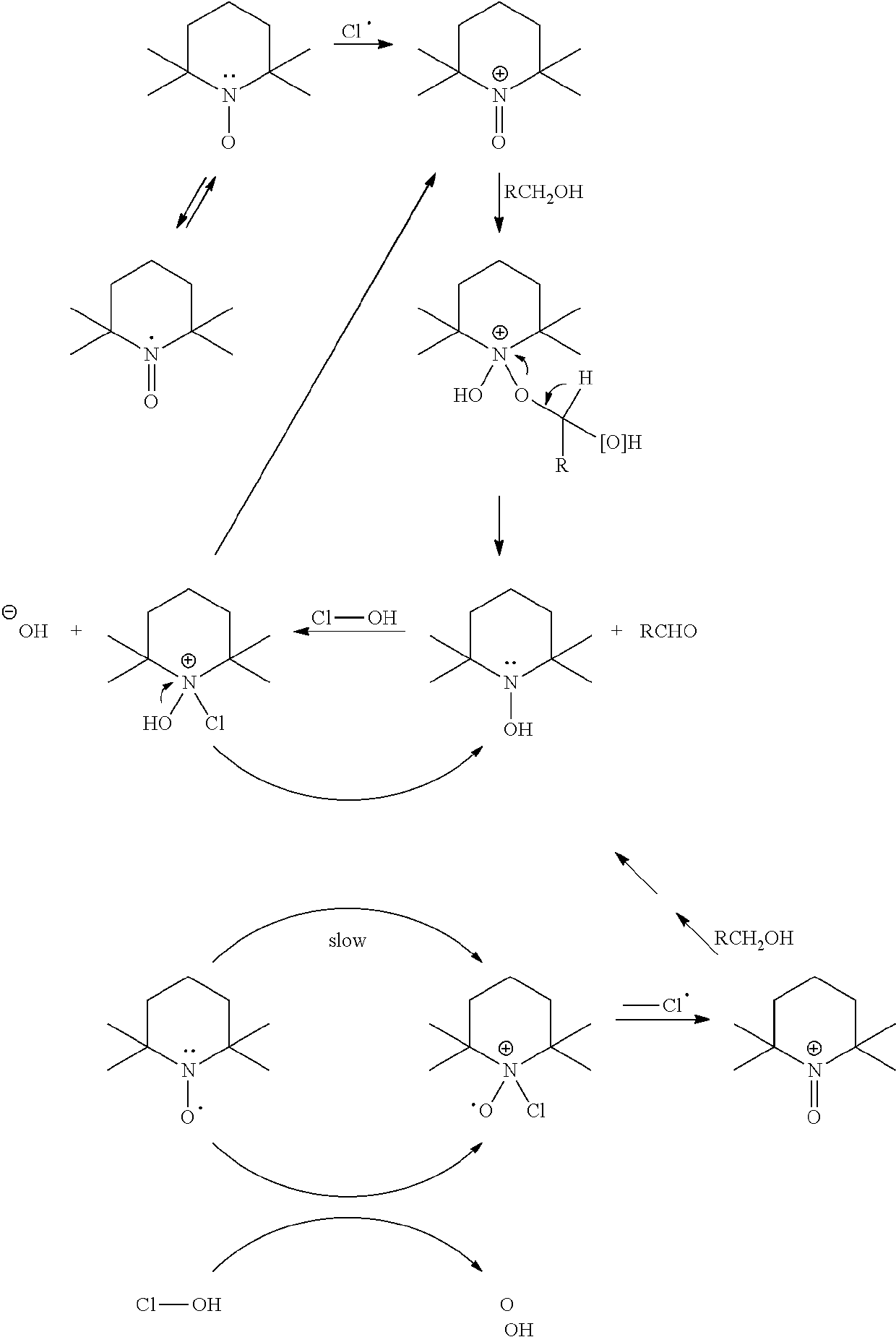Method for catalytic oxidation of cellulose and method for making a cellulose product
a technology of cellulose and catalytic oxidation, which is applied in the field of catalytic oxidation of cellulose, can solve the problems of lowering the dp (degree of polymerization) of cellulose, reducing the strength properties and gel formation ability of nanofibrillar cellulose, and the problem of bromine compounds in the oxidation reaction, so as to achieve selectively and effectively oxidize the c-6 hydroxyl group
- Summary
- Abstract
- Description
- Claims
- Application Information
AI Technical Summary
Benefits of technology
Problems solved by technology
Method used
Image
Examples
example 1
[0070]Activation of Radical TEMPO By HOCl
[0071]0.375 g radical TEMPO was weighted and transferred to closed glass bottle. 50 ml of water was added to bottle. 4 ml of NaClO (12.9%) solution was added to TEMPO solution. pH of TEMPO solution was adjusted to 7.5 by 1 M H2SO4 using pH meter. Solution was mixed strongly until all radical TEMPO was dissolved.
[0072]HOCl Activated TEMPO Oxidation
[0073]243 g (48 g as dry) never-dried birch pulp was weighted in closed vessel. Activated TEMPO solution was mixed with pulp. Pulp was shifted to Buchi reactor and 819 ml water was mixed with pulp. Temperature of pulp was set to 18° C. 63 ml (12.9%) NaClO was added to reactor by pump while pulp was mixed strongly. NaClO addition was over after 13 min. pH was kept under 9 during NaClO addition by controlling pumping speed. Temperature of pulp was lifted to 25° C. after NaClO addition and pH was controlled by titrator (pH 9, 1 M NaOH) until all NaClO was consumed (after 152 min). Active chlorine titrat...
examples 2 and 3
[0076]The Examples 2 and 3 were performed according to Example 1 using the same activation and oxidation procedures. In Example 2, never dried pulp was used and the pH was kept in 9 during the oxidation step, as in Example 1, whereas in the Example, 3 dried pulp was used and the pH was kept in 8. The results are shown in Table 1 below. Never dried pulp and pH 9 (Examples 1 and 2) yield better results in terms of conversion degree, selectivity and reaction time as dried pulp and pH 8 (Example 3).
Example 4 (TEMPO Oxidation By ClO2 Activation, Ccomparative Example)
[0077]Activation of Radical TEMPO By ClO2
[0078]0.375 g radical TEMPO was weighted and transferred to closed glass bottle. 40 ml of ClO2 water (5.9 g ClO2 / l) was added to bottle. Solution was mixed strongly until all radical TEMPO was dissolved.
[0079]ClO2 Activated TEMPO Oxidation
[0080]133 g rewetted dried birch pulp (48 g as dry) was weighted in closed vessel. Activated TEMPO solution was mixed with pulp. Pulp was shifted to...
example 5 (
Fibrillation of Pulp By Fluidizator to NFC)
[0082]Pulp consistency of the oxidized pulp sample of Example 1 was adjusted to approximately 2.0% by water. Sample was mixed by Turrax 10 min. pH was adjusted to 9 by NaOH and pH meter. Pulp solution was forced by 2000 bar pressure through 200 μm chamber and 100 μm chamber (=1 pass) of fluidizator (Microfluidics M110P). Pulp dispersion formed a gel in fluidization.
[0083]In order to characterize NFC gel, turbidity and Brookfield viscosity were measured.
[0084]Turbidity may be measured quantitatively using optical turbidity measuring instruments. There are several commercial turbidometers available for measuring quantitatively turbidity. In the present case the method based on nephelometry is used. The units of turbidity from a calibrated nephelometer are called Nephelometric Turbidity Units (NTU). The measuring apparatus (turbidometer) is calibrated and controlled with standard calibration samples, followed by measuring of the turbidity of t...
PUM
| Property | Measurement | Unit |
|---|---|---|
| pH | aaaaa | aaaaa |
| temperature | aaaaa | aaaaa |
| yield stress | aaaaa | aaaaa |
Abstract
Description
Claims
Application Information
 Login to View More
Login to View More - R&D
- Intellectual Property
- Life Sciences
- Materials
- Tech Scout
- Unparalleled Data Quality
- Higher Quality Content
- 60% Fewer Hallucinations
Browse by: Latest US Patents, China's latest patents, Technical Efficacy Thesaurus, Application Domain, Technology Topic, Popular Technical Reports.
© 2025 PatSnap. All rights reserved.Legal|Privacy policy|Modern Slavery Act Transparency Statement|Sitemap|About US| Contact US: help@patsnap.com



